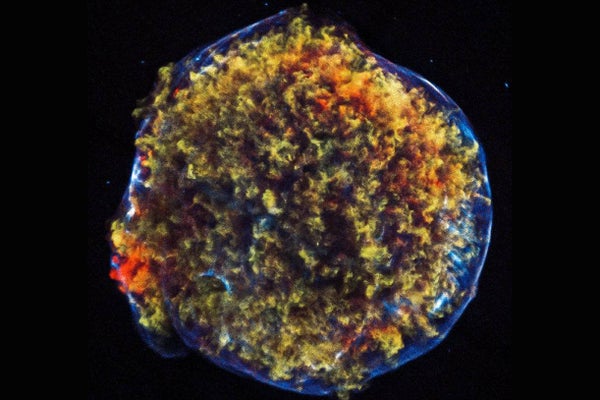Baby pictures of a newborn supernova have captured this stellar explosion after the first half-dozen hours of its life, shedding light on how these giant explosions happen, a new study finds.
This newly discovered cosmic baby is the type of supernova that occurs when a giant star runs out of fuel and explodes. Supernovas are so bright that they can briefly outshine all of the other stars in their home galaxy.
Astronomers have previously seen glimpses of supernovas within the first minutes after they explode. However, until now, researchers had not captured light from a newborn supernova across the so many wavelengths—including radio waves, visible light and X-rays. The new images add to evidence that suggests that these dying stars may signal their upcoming demise by spewing a disk of material in the months before their deaths, according to a paper describing the finding. [Know Your Novas: Star Explosions Explained (Infographic)]
On supporting science journalism
If you're enjoying this article, consider supporting our award-winning journalism by subscribing. By purchasing a subscription you are helping to ensure the future of impactful stories about the discoveries and ideas shaping our world today.
Much remains unknown about how and why dying stars can detonate with such violence. Studying the final years of a star that is destined to die as a supernova could reveal key details about the way in which these explosions happen, but stars in these brief, final stages are rare—statistically, it is very likely that none of the 100 billion to 400 billion stars in the Milky Way galaxyare within one year of dying as a supernova, according to the new paper.
Now scientists report the discovery of a supernova just 3 hours after it exploded, helping them capture "the earliest spectra ever taken of a supernova explosion," said study lead author Ofer Yaron, an astrophysicist at the Weizmann Institute of Science in Rehovot, Israel. A light spectrum is essentially detailed look at the wavelengths of light emitted by an object. Because chemical elements can absorb certain wavelengths, stellar spectra can be used to reveal the composition of a star.
"Until several years ago, catching a supernova a week after explosion was regarded as early," Yaron told Space.com. "This is not the case anymore."
A supernova is born
The astronomers detected the supernova known as SN 2013fs on Oct. 6, 2013, using the data from the Intermediate Palomar Transient Factory (iPTF) based at the Palomar Observatory in California. Its star was likely a red supergiant about 10 to 17 times heavier than the sun and several hundred times wider than the sun, Yaron said.
The supernova detonated about 160 million light-years away in a spiral galaxy called NGC 7610. This galaxy is relatively close to the Milky Way, making it easier for scientists to aim more telescopes at it and detect signals from it that span almost the entire the spectrum of light, from radio waves to X-rays. Observations of the supernova were made with telescopes at the Keck Observatory in Hawaii and NASA's Swift satellite starting about 6 hours after the explosion, Yaron explained.
SN 2013fs was the most common variety of supernova: a Type II. This kind of supernova happens when the core of a massive star runs out of fuel, collapses to an extraordinarily dense nugget in a fraction of a second and then bounces and blasts its material outward.
The astronomers captured pictures of the newborn supernova early enough to spot a disk of matter the star expelled just before its demise. Normally supernovas are seen after the shockwave from the explosions have swept away such material and any secrets that the disk might have contained.
The researchers found that a year or so before this star died, it rapidly spewed out vast amounts of material, equal to about one-thousandth of the sun's mass, at speeds of nearly 224,000 mph (360,000 km/h). Previous research had seen cases where such early eruptions occurred among unusual subgroups of Type II supernovas, but these new findings suggest that such outpourings also precede more common kinds of Type II supernovas.
"It's as if the star 'knows' its life is ending soon, and puffing material at an enhanced rate during its final breaths," Yaron told Space.com. "Think of a volcano or geyser bubbling before an eruption."
These findings suggest that a star may be unstable months before its turns into a Type II supernova. As such, "the structure of the star when it explodes may be different than that assumed so far," Yaron said. For instance, the core of a star may experience upheavals during its final days, causing strong winds to travel from the depths of the star all the way to its surface and beyond.
New, automated surveys of the sky such as the iPTF have begun capturing supernovas a day or less after they explode.
"With the help of new sky surveys coming up in the very near future, we expect to significantly increase the number of supernova events for which we are able to obtain early observations within hours and maybe minutes from explosion," Yaron said.
The scientists detailed their findings online Feb. 13 in the journal Nature Physics.
First Supernova Shock Wave Image Snapped by Planet-Hunting Telescope
Most Powerful Supernova Ever Discovered Blasts Away Competition
Copyright 2017 SPACE.com, a Purch company. All rights reserved. This material may not be published, broadcast, rewritten or redistributed.
